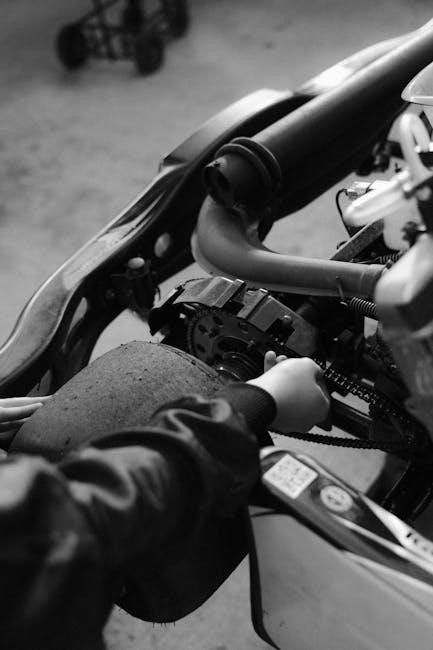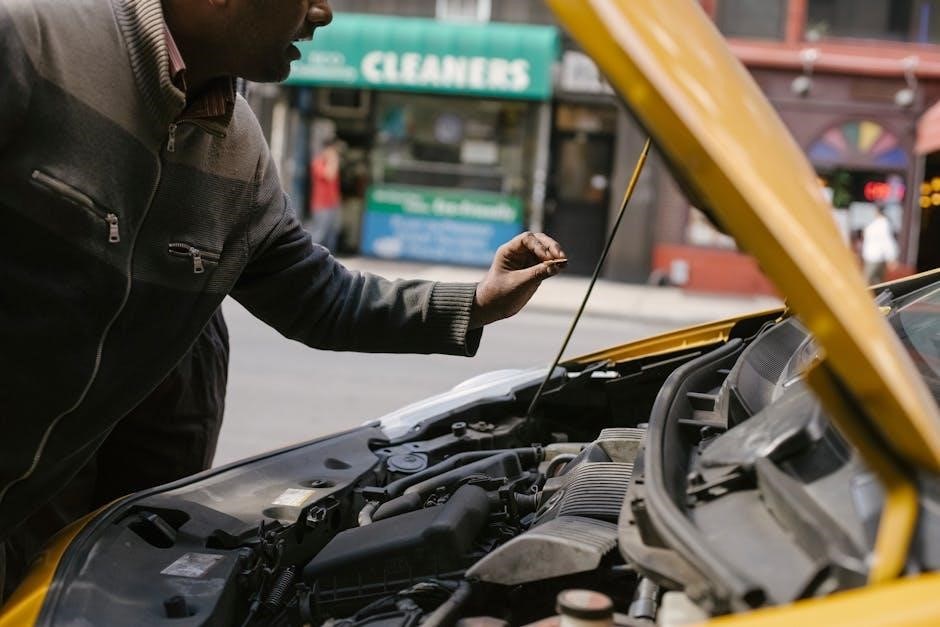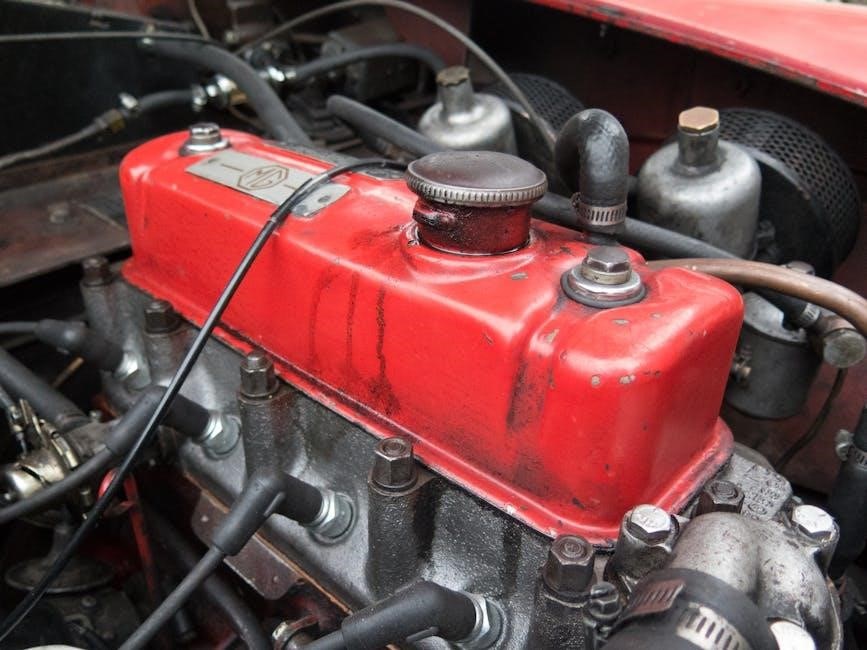A motor can be manually started using a rheostat to control voltage and current, reducing inrush current during startup. This method provides a smooth initiation of motor operation.
What is a Rheostat?

A rheostat is an electrical component that acts as a variable resistor, enabling the adjustment of resistance in a circuit. It consists of a resistive element and a sliding contact, allowing for precise control over voltage and current. This device is widely used in applications requiring fine-tuned adjustments, such as motor speed control, audio systems, and electrotherapy equipment.
By varying the resistance, a rheostat can reduce voltage and current in a circuit, making it ideal for applications like manually starting motors. It provides a simple yet effective way to manage electrical parameters, ensuring smooth operation and protecting components from excessive current surges. Rheostats are versatile tools, offering a practical solution for controlling electrical systems efficiently.
Basic Principles of Motor Starting

Motor starting involves initiating rotation from a standstill, requiring careful management of voltage and current. When a motor starts, it draws a high inrush current due to its low impedance in a stationary state. This high current can strain the power supply and potentially damage the motor or connected equipment. To mitigate this, methods like voltage reduction are employed to limit the current surge during startup.
A rheostat is commonly used for this purpose, as it allows gradual voltage adjustment. By initially reducing the voltage, the motor starts with a lower current, preventing excessive stress on the system. As the motor gains speed, the rheostat is adjusted to increase voltage, ensuring smooth acceleration. This principle ensures efficient and safe motor starting, protecting both the motor and the power supply from damage caused by high inrush currents.
Advantages of Using a Rheostat for Motor Starting
Using a rheostat for motor starting offers several advantages, primarily in controlling voltage and current effectively. By reducing the initial voltage, the rheostat limits the inrush current, protecting the motor and power supply from potential damage. This gradual startup also minimizes mechanical stress on the motor and connected machinery, extending their lifespan.
Additionally, the rheostat provides flexibility in adjusting the startup characteristics of the motor. It allows for a smooth acceleration, reducing the risk of voltage spikes or current surges. This method is particularly useful in applications where precise control over the startup process is essential. Furthermore, the rheostat’s ability to regulate resistance ensures efficient energy use, making it a cost-effective solution for manual motor starting systems.
Understanding the Components Involved
A rheostat, motor, and power source are essential components. The rheostat regulates resistance, controlling voltage and current during startup, while the motor and generator interact through magnetic fields and conductors.
Electrical Generators and Their Role
Electrical generators are fundamental in motor systems, operating on Faraday’s law of electromagnetic induction. They convert mechanical energy into electrical energy by moving conductors within magnetic fields. This process generates the necessary voltage to power motors. In manual motor starting, generators play a crucial role by providing the initial electromagnetic field required for motor operation. The interaction between the generator’s output and the motor’s startup characteristics ensures a controlled and efficient process. Rheostats are often used in conjunction with generators to regulate voltage and current, preventing excessive inrush current during motor startup. This synergy between generators and rheostats is essential for smooth and safe motor initiation. Without generators, the electromagnetic induction necessary to start motors manually with rheostats would not be possible, making them indispensable in such systems.
- Generators produce electromagnetic fields through moving conductors.
- They supply the initial voltage for motor startup.
- Rheostats regulate generator output for controlled motor starting.
Magnetic Fields and Conductors in Motor Systems
Magnetic fields and conductors are essential components in motor systems, enabling the conversion of electrical energy into mechanical energy. Faraday’s law of electromagnetic induction states that a conductor moving within a magnetic field induces an electromotive force (EMF), which drives the motor. Conductors, typically in the form of coils or windings, interact with the magnetic field to produce rotation. This interaction is fundamental to motor operation. In manual starting with a rheostat, the magnetic field’s strength and the conductor’s movement are regulated to control voltage and current. The rheostat adjusts resistance, reducing inrush current and ensuring a smooth startup. The interplay between magnetic fields and conductors is critical for efficient motor performance, as it directly influences torque and speed. Understanding this relationship is vital for effective motor control and energy management.
- Magnetic fields induce voltage in moving conductors.
- Conductors interact with fields to produce motor rotation.
- Rheostats regulate this interaction during startup.

Difference Between AC and DC Motors
AC and DC motors differ primarily in their power sources and operational principles. AC motors use alternating current, which reverses direction periodically, while DC motors rely on direct current, which flows in one direction. AC motors are commonly used in household appliances and industrial applications due to their ability to operate efficiently over long distances and their ease of speed control. DC motors, on the other hand, are often used in applications requiring precise speed control, such as in robotics and automotive systems. When starting a motor manually with a rheostat, the choice between AC and DC depends on the specific application. DC motors typically require a rheostat for starting to limit initial current, while AC motors may use different methods. Understanding these differences is crucial for selecting the appropriate motor and control method for a given task.

- AC motors use alternating current.
- DC motors use direct current.
- Starting methods vary between AC and DC motors.

Practical Application of Rheostat in Motor Starting
A rheostat is used to manually start motors by adjusting voltage and current, ensuring a smooth initiation of operation and preventing high inrush current spikes.
Step-by-Step Guide to Manually Starting a Motor
Manually starting a motor with a rheostat involves a systematic approach to ensure smooth operation and prevent damage. First, ensure the motor is disconnected from any load and the rheostat is set to its maximum resistance. Connect the rheostat in series with the motor circuit, typically on the armature side for DC motors. Apply power to the circuit and monitor the current and voltage using appropriate instruments. Gradually reduce the rheostat’s resistance to increase the voltage supplied to the motor, allowing it to start smoothly without high inrush current. Once the motor reaches full speed, adjust the rheostat to its minimum resistance to remove it from the circuit. Finally, connect the load to the motor only after it has stabilized at full operational speed.

Voltage Drop and Current Reduction with Rheostat
A rheostat plays a crucial role in managing voltage drop and reducing current during motor starting. By introducing a variable resistance in the circuit, the rheostat limits the initial voltage supplied to the motor, thereby reducing the inrush current. This is essential because motors draw high current when starting from rest, which can strain the power supply and potentially damage the motor. The rheostat creates a voltage drop proportional to the resistance, allowing the motor to accelerate gradually. As the motor gains speed, its impedance increases, naturally reducing the current flow. The rheostat can then be adjusted to reduce its resistance, increasing the voltage applied to the motor until it operates at full capacity. This method ensures a smooth and controlled startup, minimizing electrical stress and enhancing safety. It is particularly effective in DC motor applications where current control is critical during initialization.
Safety Precautions and Best Practices
When manually starting a motor with a rheostat, adhering to safety precautions is paramount. Always ensure the circuit is de-energized before making adjustments to prevent electrical shocks or short circuits. Use appropriate personal protective equipment, such as insulated gloves and safety goggles, to protect against potential arcing or flying debris. Properly configure the rheostat to match the motor’s specifications, as incorrect settings can lead to overheating or damage. Regularly inspect the rheostat and associated wiring for wear or damage, addressing issues promptly to avoid hazards. Ensure the motor is properly grounded to prevent voltage spikes. Follow the manufacturer’s guidelines for both the motor and rheostat, and never exceed the rated current or voltage limits. Additionally, keep the workspace well-ventilated to prevent the accumulation of fumes from heating components. By following these best practices, operators can ensure a safe and reliable motor starting process.

Modern Developments and Considerations
Modern advancements favor electronic DC drives over rheostats for motor starting, offering precise control and efficiency. These systems reduce energy consumption and enhance safety, making them preferable in contemporary applications.
Electronic DC Drives and Their Impact
Electronic DC drives have revolutionized motor starting by offering advanced control and efficiency compared to traditional rheostat methods. These drives use semiconductor technology to regulate voltage and current precisely, eliminating the need for manual adjustments. They provide features like soft-starting, which gradually increases motor speed, reducing inrush current and mechanical stress. Electronic DC drives also support dynamic speed control, enabling motors to operate efficiently under varying load conditions. This technology minimizes energy consumption and heat generation, making it environmentally friendly. Additionally, these drives often include protective features such as overcurrent and voltage surge protection, enhancing system reliability. Maintenance is simplified due to fewer moving parts compared to rheostats. With real-time monitoring and programmable settings, electronic DC drives are now the preferred choice for modern DC motor systems, replacing rheostats in both new and upgraded applications.
Using Rheostats in Electrotherapy Applications
Rheostats play a significant role in electrotherapy by allowing precise control over voltage and current during treatment sessions. In electrotherapy, rheostats are used to adjust the intensity of electrical currents applied to the body, ensuring safe and effective therapy. By modifying resistance, rheostats enable therapists to customize treatment parameters for individual patient needs. This capability is crucial for therapies like electrical stimulation, where controlled current levels are essential for muscle rehabilitation or pain relief. Rheostats also provide a smooth transition between current levels, preventing sudden shocks or discomfort. Their durability and ease of operation make them a reliable tool in clinical settings. Furthermore, rheostats facilitate the accurate measurement of resistance in biological tissues, aiding in diagnostic procedures. Overall, rheostats are indispensable in modern electrotherapy, offering both precision and safety in therapeutic applications.
Future Trends in Motor Starting Technologies
Future trends in motor starting technologies are expected to focus on advanced electronic solutions, reducing reliance on manual methods like rheostats. Solid-state drives and smart motor controllers are becoming prevalent, offering precise control and energy efficiency. These systems integrate sensors and IoT capabilities for real-time monitoring and predictive maintenance, enhancing operational reliability. Additionally, the development of variable frequency drives (VFDs) and regenerative braking systems is revolutionizing motor control, optimizing performance and reducing energy consumption. Sustainability is a key driver, with technologies aimed at minimizing power losses and improving overall system efficiency. As automation advances, manual starting methods like rheostats may be phased out in favor of more sophisticated, automated solutions. However, rheostats will still find niche applications where simplicity and cost-effectiveness are prioritized. The integration of AI and machine learning into motor control systems is also anticipated, enabling smarter and more adaptive motor starting solutions.
